Kidney Cancer
Background
Kidney cancer rates have increased over time, which is attributable to changes in medical imaging for disease detection as well as changes in the prevalence of lifestyle and behavioural risk factors [1]. Tobacco smoking is the largest well-known risk factor for kidney cancer and increases the risk of disease by 50% [2].
Known occupational risk factors
-
- X- and gamma radiation [3]
- Trichloroethylene (TCE) [3]
Possible occupational risk factors
-
- Arsenic and inorganic arsenic compounds [3]
- Cadmium and cadmium compounds [3]
- Perfluorooctanoic acid (PFOA) [3]
- Printing processes [3]
- Welding fumes [3]
- Gasoline and diesel exhaust [4]
Key Findings
Increased risks of kidney cancer were detected among groups potentially exposed to TCE, one of the few well-established occupational risk factors for kidney cancer, including metal manufacturing, several metalworking occupations, and certain transportation equipment manufacturing industries. There was also a strong elevated risk among firefighting occupations, who may be exposed to many different chemicals [5,6]. No excess risk was observed among workers in printing-related occupations or industries or among welders and flame cutters.
Metal work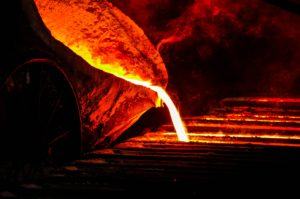
Workers in metal manufacturing, including metalworkers, may be exposed to TCE, which is used for metal degreasing. These workers tend to be the most heavily exposed [7]. Metal machine tool operators are among the largest occupational groups exposed to TCE [8]. Workers in metal-related occupations may also be exposed to cadmium. Groups working with minerals containing copper and iron, which showed increases risks in the ODSS, may also be exposed to arsenic [9].
-
- Moulding, coremaking, and metal casting occupations: 1.41 times the risk
- Occupations in labouring and other elemental work, metal processing: 1.37 times the risk
- Metal machine tool operating occupations: 1.34 times the risk
- Primary metal manufacturing industries: 1.23 times the risk
- Iron foundries: 1.58 times the risk
- Copper and copper alloy rolling, casting and extruding: 1.57 times the risk
- Iron and steel mills: 1.21 times the risk
Transportation equipment manufacturing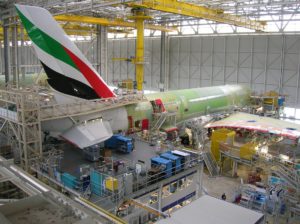
TCE may be used to degrease metal parts in motor vehicle manufacturing. Cadmium batteries are used in the railroad industry as a source of emergency power and for starting engines [10].
-
- Aircraft fabricating and assembling occupations, not elsewhere classified: 1.39 times the risk
- Motor vehicle manufacturers industry: 1.17 times the risk
- Railroad rolling stock manufacturing industry: 1.56 times the risk
Fire-fighting occupations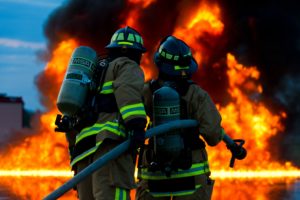
Firefighters are exposed to potentially harmful substances and work-related circumstances including shiftwork, flame retardants, and diesel engine exhaust, and when fighting fires where they can be exposed to various mixtures of particulates, gases and fumes [11]. More recent studies [12–14] and meta-analyses [11,15–17] have generally not found consistent evidence of an increased risk of kidney cancer associated with firefighting.
-
- Fire-fighting occupations: 1.55 times the risk
Truck drivers 
Truck drivers showed increased risks of kidney cancer, which may relate to high smoking prevalence. Emerging research has also linked occupational gasoline and diesel exhaust with increased risk of kidney cancer [4].
-
- Truck drivers: 1.29 times the risk
Other findings
Elevated risks of kidney cancer were also observed for several additional groups with potential exposure to TCE and PFOA. Launderers and dry cleaners, a group that may work with PFOA and TCE to remove stains, showed an increased risk of disease that was based on a relatively small number of cases. Other groups with potential exposure to TCE, including groups within textile fabricating, assembling and repair (e.g., sewing machine operators) had small or no cases of kidney cancer, or too few cases to generate precise estimates. Occupational risks for kidney cancer among baking occupations are unclear.
Certain nursing subgroups showed elevated rates of kidney cancer, but this was not consistently observed. For instance, nurses and orderlies are among the occupation groups with the largest number of workers exposed to ionizing radiation [18]. Nurses showed decreased rates of kidney cancer, but orderlies and other groups within nursing showed increased rates.
-
- Bonding and cementing occupations, rubber, plastic and related products: 1.84 times the risk
- Nursing, therapy and related assisting occupations, nec*: 1.51 times the risk
- Materials handling equipment operators nec: 1.42 times the risk
- Launderers and dry cleaners: 1.41 times the risk
- Bakers and confectionery makers: 1.37 times the risk
- Stationary engine and utilities equipment operating and related occupations nec: 1.35 times the risk
- Textile processing occupations: 1.30 times the risk
- Nursing aides and orderlies: 1.21 times the risk
*Nursing therapy and related assisting occupations, nec, include workers who provide support in diagnostic and therapeutic procedures
Relative Risk by Industry and Occupation
Figure 1. Risk of kidney cancer diagnosis among workers employed in each industry group relative to all others, Occupational Disease Surveillance System (ODSS), 1999-2016
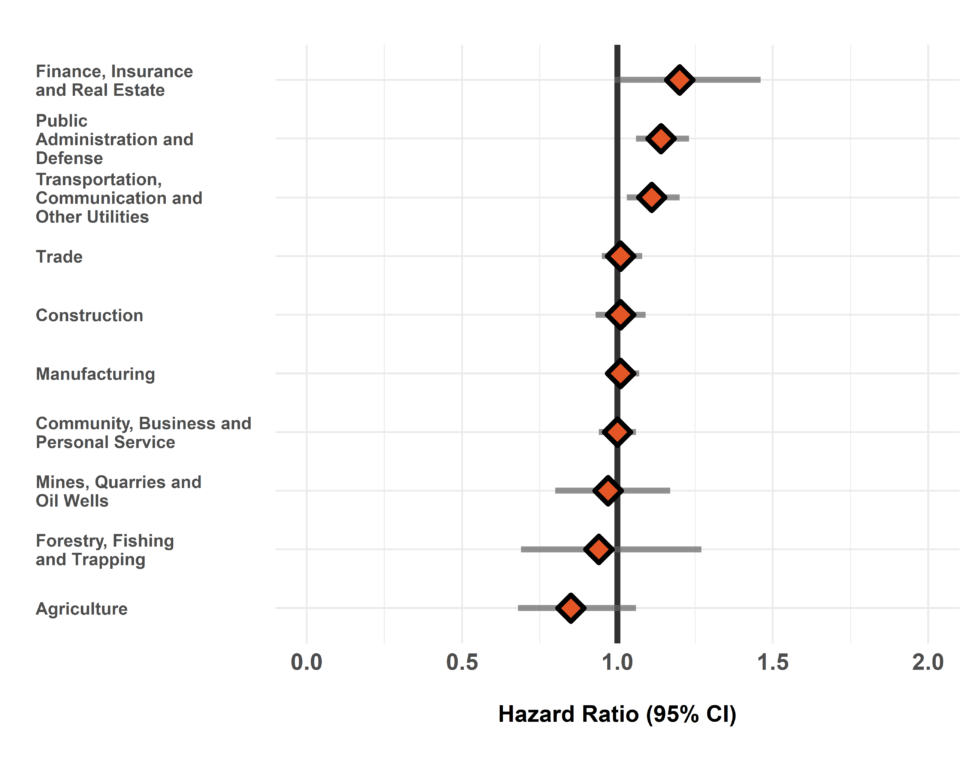
The hazard ratio is an estimate of the average time to diagnosis among workers in each industry/occupation group divided by that in all others during the study period. Hazard ratios above 1.00 indicate a greater risk of disease in a given group compared to all others. Estimates are adjusted for birth year and sex. The width of the 95% Confidence Interval (CI) is based on the number of cases in each group (more cases narrows the interval).
Figure 2. Risk of kidney cancer diagnosis among workers employed in each occupation group relative to all others, Occupational Disease Surveillance System (ODSS), 1999-2016
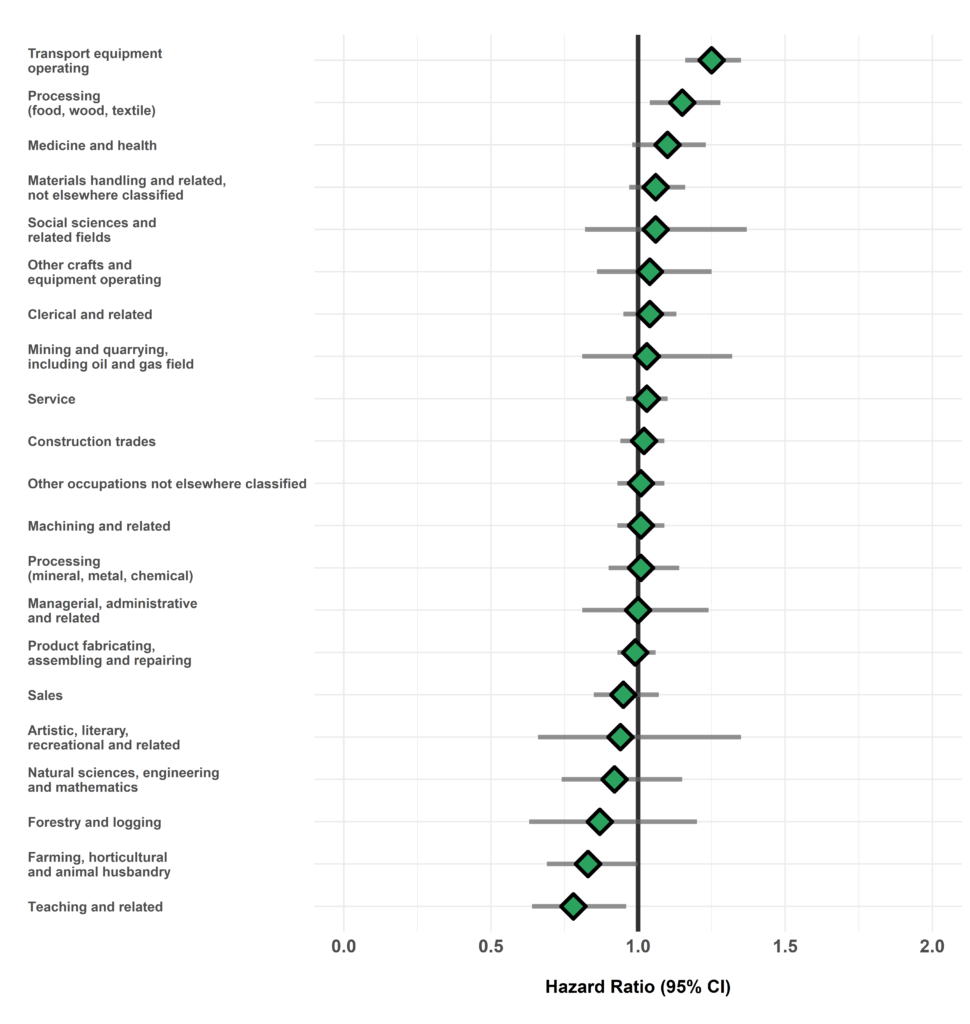
The hazard ratio is an estimate of the average time to diagnosis among workers in each industry/occupation group divided by that in all others during the study period. Hazard ratios above 1.00 indicate a greater risk of disease in a given group compared to all others. Estimates are adjusted for birth year and sex. The width of the 95% Confidence Interval (CI) is based on the number of cases in each group (more cases narrows the interval).
Table of Results
Table 1. Surveillance of Kidney Cancer: Number of cases, workers employed, and hazard ratios in each industry (SIC)
| SIC Code * | Industry Group | Number of cases | Number of workers employed | Hazard Ratio (95% CI) † |
| 1 | Agriculture | 81 | 35011 | 0.85 (0.68-1.06) |
| 2/3 | Forestry, Fishing and Trapping |
42 | 10698 | 0.94 (0.69-1.27) |
| 4 | Mines, Quarries and Oil Wells |
110 | 23207 | 0.97 (0.80-1.17) |
| 5 | Manufacturing | 2608 | 693516 | 1.01 (0.97-1.07) |
| 6 | Construction | 748 | 210968 | 1.01 (0.93-1.09) |
| 7 | Transportation, Communication and Other Utilities |
776 | 197177 | 1.11 (1.03-1.20)** |
| 8 | Trade | 1194 | 429242 | 1.01 (0.95-1.08) |
| 9 | Finance, Insurance and Real Estate |
103 | 23986 | 1.20 (0.99-1.46) |
| 10 | Community, Business and Personal Service |
1501 | 599525 | 1.00 (0.94-1.06) |
| 11 | Public Administration and Defense |
758 | 190853 | 1.14 (1.06-1.23)*** |
| * SIC: Standard Industrial Classification (1970) | ||||
| † Hazard rate in each group relative to all others | ||||
Table 2. Surveillance of Kidney Cancer: Number of cases, workers employed, and hazard ratios in each occupation (CCDO) group
| CCDO Code * | Occupation Group | Number of cases | Number of workers employed | Hazard Ratio (95% CI) † |
| 11 | Managerial, administrative and related |
88 | 30986 | 1.00 (0.81-1.24) |
| 21 | Natural sciences, engineering and mathematics |
80 | 26338 | 0.92 (0.74-1.15) |
| 23 | Social sciences and related fields |
60 | 30710 | 1.06 (0.82-1.37) |
| 25 | Religion | 128 | — | |
| 27 | Teaching and related | 95 | 48478 | 0.78 (0.64-0.96)* |
| 31 | Medicine and health | 329 | 135333 | 1.10 (0.98-1.23) |
| 33 | Artistic, literary, recreational and related |
30 | 14994 | 0.94 (0.66-1.35) |
| 41 | Clerical and related | 570 | 197314 | 1.04 (0.95-1.13) |
| 51 | Sales | 314 | 148106 | 0.95 (0.85-1.07) |
| 61 | Service | 1072 | 370832 | 1.03 (0.96-1.10) |
| 71 | Farming, horticultural and animal husbandry |
113 | 50140 | 0.83 (0.69-1.00) |
| 73 | Fishing, hunting, trapping and related |
<5 | 557 | — |
| 75 | Forestry and logging | 37 | 10683 | 0.87 (0.63-1.20) |
| 77 | Mining and quarrying, including oil and gas field |
64 | 13043 | 1.03 (0.81-1.32) |
| 81 | Processing (mineral, metal, chemical) |
271 | 79234 | 1.01 (0.90-1.14) |
| 82 | Processing (food, wood, textile) |
355 | 99234 | 1.15 (1.04-1.28)** |
| 83 | Machining and related | 735 | 189407 | 1.01 (0.93-1.09) |
| 85 | Product fabricating, assembling and repairing |
1223 | 328276 | 0.99 (0.93-1.06) |
| 87 | Construction trades | 849 | 215587 | 1.02 (0.94-1.09) |
| 91 | Transport equipment operating |
775 | 168070 | 1.25 (1.16-1.35)*** |
| 93 | Materials handling and related, not elsewhere classified |
522 | 153047 | 1.06 (0.97-1.16) |
| 95 | Other crafts and equipment operating |
113 | 28301 | 1.04 (0.86-1.25) |
| 99 | Other occupations not elsewhere classified | 696 | 215234 | 1.01 (0.93-1.09) |
| * CCDO: Canadian Classification Dictionary of Occupations (1971) | ||||
| † Hazard rate in each group relative to all others | ||||
Please note that ODSS results shown here may differ from those previously published or presented. This may occur due to changes in case definitions, methodological approaches, and the ongoing nature of the surveillance cohort.
References
- De P, Otterstatter MC, Semenciw R, Ellison LF, Marrett LD, Dryer D. Trends in incidence, mortality, and survival for kidney cancer in Canada, 1986–2007. Cancer Causes Control [Internet]. 2014;25(10):1271–81.
- Chow W-H, Dong LM, Devesa SS. Epidemiology and risk factors for kidney cancer. Nat Rev Urol [Internet]. 2010;7(5):245.
- IARC Working Group. List of Classifications by cancer sites with sufficient or limited evidence in humans, Volumes 1 to 113 [Internet]. Lyon, France: International Agency for Research on Cancer (IARC);
- Peters CE, Parent MÉ, Harris SA, Bogaert L, Latifovic L, Kachuri L, et al. Occupational Exposure to Diesel and Gasoline Engine Exhausts and the Risk of Kidney Cancer in Canadian Men. Ann Work Expo Heal [Internet]. 2018;62(8):978–89.
- Guidotti TL. Health risks and occupation as a firefighter [Internet]. 2014.
- Al-Malki AL. Serum heavy metals and hemoglobin related compounds in Saudi Arabia firefighters. J Occup Med Toxicol [Internet]. 2009;4(1):1–6.
- IARC Working Group. IARC monographs on the evaluation of carcinogenic risks to humans-Trichloroethylene, Tetrachloroethylene, and Some Other Chlorinated Agents. [Internet]. Vol. 106. Lyon: International Agency for Research on Cancer (IARC); 2014.
- CAREX Canada. Trichloroethylene [Internet]. [cited 2020 Oct 26].
- CAREX Canada. Arsenic [Internet]. [cited 2020 Oct 26].
- Putois F. Putois 1995- Market for nickel cadmium batteries. J Power Sources. 1995;57(1–2):67–70.
- LeMasters GK, Genaidy AM, Succop P, Deddens J, Sobeih T, Barriera-Viruet H, et al. Cancer risk among firefighters: A review and meta-analysis of 32 studies. J Occup Environ Med [Internet]. 2006;48(11):1189–202.
- Tsai RJ, Luckhaupt SE, Schumacher P, Cress RD, Deapen DM, Calvert GM. Risk of cancer among firefighters in California, 1988-2007. Am J Ind Med [Internet]. 2015;58(7):715–29.
- Kang D, Davis LK, Hunt P, Kriebel D. Cancer incidence among male Massachusetts firefighters, 1987-2003. Am J Ind Med [Internet]. 2008;51(5):329–35.
- Glass DC, Pircher S, Del Monaco A, Vander Hoorn S, Sim MR. Mortality and cancer incidence in a cohort of male paid Australian firefighters. Occup Environ Med [Internet]. 2016;
- Casjens S, Brüning T, Taeger D. Cancer risks of firefighters: a systematic review and meta-analysis of secular trends and region-specific differences. Int Arch Occup Environ Health [Internet]. 2020;93(7):839–52.
- Youakim S. Risk of cancer among firefighters: A quantitative review of selected malignancies. Arch Environ Occup Heal [Internet]. 2006;61(5):223–31.
- IARC Working Group. IARC Monographcs on the Evaluation of Carcinogenic Risks to Humans- Firefighting [Internet]. Lyon, France: International Agency for Research on Cancer (IARC); 2007.
- CAREX Canada. Health Care sector report [Internet]. 2019.
